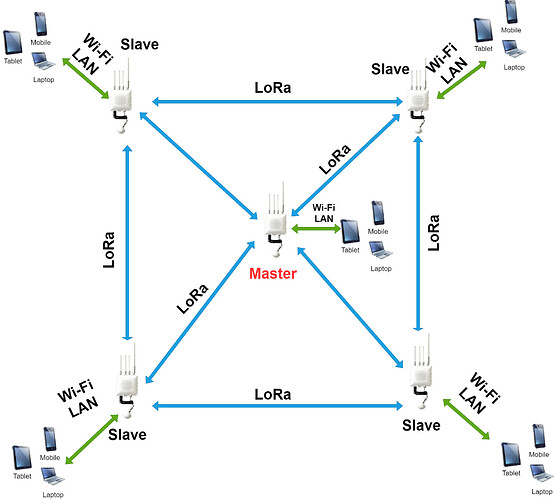Greetings … There is a need to create a network based on LORA for connecting devices at a distance of 5-10 km (line of sight) … There is a desire to use ready-made solutions for these purposes in the form of RAK 7249 gateways or similar (having a WIFI on board, GPS, LAN). The guys on the forum explained to me that gateways cannot communicate with each other in a stock state, so there is a desire to try to modify them in terms of software to perform this kind of task (If I understood correctly in terms of hardware, there are no restrictions). A request to respond to those who had experience in building this kind of networks, and can provide any help in this matter … For ease of perception of what I want to do, I attach the connection diagram below.
If you are going to transfer a huge amount of data like images, videos, files, etc. that is not possible. LoRa is for byte-size IoT data transmissions only.
Exactly, LoRa can’t remotely support the bandwidth needs of just about all uses of ordinary computers, it’s intended for small infrequent monitoring and to a lesser extent control messages.
The type of system diagrammed is traditionally where something like point-to-point microwave dish links would be used, or possibly other radio solutions with directional antennas.
You can probably check ubiquity, mikrotik, tplink, etc. for long range backhaul network links.
Thank you for the answers … There is no need to transfer large amounts of information and high speeds … I am interested in the transfer of private encrypted packets from device to device within the described topology, in most cases even without uploading to the Internet … At the initial stage I am interested in the possibility of connecting two RAC 7249 modules in point-to-point mode, perhaps there are people who can help in the implementation of this kind of task …
You are probably still not understanding how narrow this pipe actually is.
That’s not really what those are designed for, they are designed to be gateways for LoRaWAN or something else which uses the radio in a similar way, which is very distinct from what you are trying to do.
You’d probably be better off using simple node-type LoRa radios and looking at some of the point to point links people have done.
But again, you’re probably going to find that LoRa is not the right technology for your need.
Node devices do not have WIFI and LAN on board (or am I shying and there are such?), And a gateway in terms of hardware is an ideal candidate for this kind of task … But if there are node devices with WIFI and LAN support, I will be grateful for links to this kind of device … Best regards, Alex
My reference was to node-type radios - parts like the sx1262 or sx1276.
The much more complicated and expensive “LoRa concentrator card” used in gateways are really not intended for any purpose other than being a gateway in a LoRaWAN type network. The chip vendor, Semtech, doesn’t publish a data sheet with a register listing, they give you example code for using it in a LoRaWAN-like setting, which you’d have to adapt to use it for anything else. Nor would a vendor of gateway boxes (such a card hosted by an embedded Linux system) be likely to offer you much support in figuring out how to use the product for an unintended purpose.
If you want to play with point to point LoRa long enough to understand why it’s not really suitable for your needs, you’d want to connect node-type radios to a platform that meets your WiFi needs, on which you’re comfortable doing serious software development. Maybe at the experimental stage that’s a raspberry pi, moving at deployment time (in the extremely unlikely even you decide to continue the project after experiencing the limitations) towards an OpenWRT router platform.
If you plan to have tight timing in your custom LoRa scheme, you may want to put a flash-based MCU in between the radio and your Linux system to delegate the tight timing to. That would make your project a bit like hanging a LoRa node development board off of a pi. Or maybe for starters you skip the pi, and just work with two hung off a PC. One advantage of a pi is that you could place one with a node some distance away (but at a place where there’s Internet access), and remote into the pi to work on that node while it exchanges messages with a local node connected directly to your pc.
It’s theoretically possible that an ESP32 + LoRa platform could be used in a setting like this, but you’ll likely find developing it all in that a setting a bit challenging, better to work out the (im)practicality of the whole idea in a more experimentation friendly setting and only try to shoehorn both your custom LoRa and the wifi into a little chip if you get to the point where you’ve proven that the goal is actually achievable.
One option could be to use WisBlock
RAK4631 for the LoRa P2P communication WisBlock Core Module
RAK2305 for the WiFi communication WisBlock Wireless Module
Or, if you can wait a little bit, before end of the year we will have a LoRa IO module for the WisBlock Core RAK11200
Thank you to all who responded … I will think about what to do next, taking into account the answers received …
And if you slightly change the network diagram … as shown in the picture … I wonder if there is a ready-made ETHERNET-LORA device that can communicate with the PAK7249 in two-way mode ??? If there is one on sale, I will be grateful for the link …
No, for all of the previous reasons of LoRa not being a fit for your needs.

